Regimental self-propelled anti-aircraft missile system "Strela-1"
The complex was designed to destroy air targets that fly at altitudes from 50-100 meters to 1-1,5 kilometers at speeds up to 250 meters per second, at a distance of up to 2 thousand meters. The lead developer of the complex as a whole and the anti-aircraft guided missile is OKB-16 GKOT (later it was transformed into the Precision Engineering Design Bureau (KBTM) of the Ministry of Defense Industry). This organization during the war years and the first post-war years under the leadership of the chief designer Nudelman A.E. achieved significant success in the development of anti-aircraft ship and aviation small-caliber cannon weapons. By the beginning of the 1960s. The Design Bureau has already completed the development of a complex anti-tank complex equipped with a Falanga radio-controlled missile. When developing the Strela-1 air defense system (9K31), unlike other short-range missile systems (such as the American Red Eye and Chaparel), it was decided to use a photocontrast head rather than an infrared (thermal) head on the missile homing. In those years, due to the low level of sensitivity of infrared homing heads, it was not possible to identify targets in the forward hemisphere, and therefore they fired at enemy aircraft only "in pursuit", mainly after they had completed combat missions. In such tactical conditions, there was a high probability of destroying anti-aircraft missile systems even before they launched missiles. At the same time, the use of a photocontrast homing head made it possible to destroy a target on a head-on course.
The main organization-developer of the optical GOS for an anti-aircraft guided missile was identified by the Central Design Bureau 589 GKOT, the chief designer - Khrustalev V.A. Subsequently, TsKB-589 was transformed into the TsDB Geofizika MOP, work on the homing head for the Strela guided missile was headed by D.M. Khorol.
Already in 1961, the first ballistic missile launches were conducted, and by the middle of the next year telemetry and software launches. These launches confirmed the possibility of creating a complex that basically meets the approved requirements of the Customer - the Main Missile-Artillery Directorate of the Ministry of Defense.
In accordance with the same Decree, the development of another portable anti-aircraft missile system, Strela-2, was also carried out. The overall dimensions and mass of this missile system were less than those of the Strela-1 air defense system. Initially, the development of "Strela-1" to some extent insured the work on "Strela-2", which were associated with a greater degree of those. risk. After solving the fundamental issues related to the development of the Strela-2 air defense system, the question arose about the further fate of the Strela-1 complex, which had practically the same performance characteristics. For the expedient use of the Strela-1 air defense system in the troops, the leadership of the State Committee for Defense and Defense addressed the Government and the Customer with a proposal to set higher requirements for this missile system in terms of maximum reach in height (3,5 thousand meters) and range (5 thousand km). m), abandoning the portable version of the missile system, moving to placement on a car chassis. At the same time, it was planned to increase the mass of the rocket to 25 kg (from 15 kg), diameter - up to 120 mm (from 100 mm), length - up to 1,8 m (from 1,25 m).
By this time, the customer had decided on the concept of the combat use of the Strela-1 and Strela-2 anti-aircraft missile systems. The portable complex "Strela-2" is used in the battalion level of air defense, and the self-propelled air defense system "Strela-1" - in the regimental level of air defense, in addition to the anti-aircraft self-hockey "Shilka", the firing range of which (2500 m) does not ensure the destruction of helicopters and aircraft the enemy to the line of launching guided missiles at the objects and positions of the tank (motorized rifle) regiment (from 4000 to 5000 m). Thus, the Strela 1 anti-aircraft missile system, which has an extended kill zone, fits perfectly into the military air defense system being developed. In this regard, the corresponding proposals of the industry were supported.
Somewhat later, the BRDM-1 armored reconnaissance vehicle was used as a base for the Strela-2 self-propelled anti-aircraft missile system.
It was envisaged that the anti-aircraft missile system, which has enhanced combat capabilities, will be presented for joint tests in the third quarter of 1964. But due to difficulties with working out the homing head, the work was delayed until 1967.
State tests of the prototype Strela-1 air defense missile system were carried out at 1968 at the Donguz testing ground (head of the Finogenov MI testing ground) under the guidance of the commission headed by Andersen Yu.A. The complex was adopted by the Resolution of the Central Committee of the CPSU and the USSR Council of Ministers of 25.04.1968.
Serial production of the 9А31 combat vehicle of the Strela-1 anti-aircraft missile system was launched at the Saratov MOP plant, and 9М31 missiles at the Kovrovsky mechanical plant MOP.
Nudelman A.E., Shkolikov V.I., Terentyev G.S., Paperny B.G. and others for the development of the air defense system "Strela-1" awarded the State Prize of the USSR.
The Strela-1 SAM system as part of a platoon (4 combat vehicles) was part of an anti-aircraft missile artillery battery (Shilka-Strela-1) of a tank (motorized) regiment.
The 9А31 combat vehicle of the Strela-1 complex was equipped with a PU with 4 anti-aircraft guided missiles placed on it, placed in transport-launch containers, optical means of aiming and detection, missile launch equipment and communications equipment.
The complex could fire on helicopters and aircraft flying at altitudes of 50-3000 meters at a speed of up to 220 m/s on a catch-up course and up to 310 m/s on a head-on course with course parameters up to 3 m, as well as on drifting balloons and hovering helicopters. The capabilities of the photocontrast homing head made it possible to fire only at visually visible targets located against a background of continuous cloudiness or a clear sky, at angles between directions to the sun and to the target of more than 20 degrees and with an angular excess of the line of sight of the target above the visible horizon more than 2 degrees. Dependence on the background situation, weather conditions and illumination of the target limited the combat use of the Strela-1 anti-aircraft complex. But, the average estimates of this dependence, taking into account the possibilities of actions aviation the enemy, mainly under the same conditions, and later the practical use of air defense systems in exercises and during military conflicts showed that the Strela-1 complex could be used quite often and effectively (in terms of military-economic indicators).
In order to reduce the cost and increase the reliability of the combat vehicle, the launcher was aimed at the target due to the muscular efforts of the operator. With the help of a system of lever-parallelogram devices, the operator with his hands brought the interconnected launch frame with missiles, a coarse sight and the lens of an optical sighting device to the required elevation angle (from -5 to +80 degrees), and with his feet, using knee stops connected to the seat, guided the launcher in azimuth (at the same time it repelled from a cone fixed on the floor of the car). The front wall of the tower in the sector of 60 degrees in azimuth was made of bulletproof transparent glass. Launchers in the transport position fell to the roof of the car.
Shooting in motion was ensured by the almost complete natural balance of the swinging part, as well as by combining the center of gravity of the launcher with the missiles with the intersection point of the rocking axes of the combat vehicle, thanks to the operator's ability to reflect the low-frequency oscillations of the hull.
In the 9M31 SAM, the "duck" aerodynamic scheme was implemented. The missile was aimed at the target using a homing head according to the proportional navigation method. The homing head converted the radiant energy flux from a contrasting target against the sky into an electrical signal that contains data on the angle between the "missile-target" line of sight and the GOS coordinator axis, as well as the angular velocity of the line of sight. The sensing elements in the homing head were uncooled lead-sulfur photoresistors.
Behind the homing head, the steering drive of the aerodynamic triangular rudders, the control system equipment, the warhead and the optical fuse were sequentially placed. Behind them was a solid rocket engine, trapezoidal wings were fixed on its tail section. The rocket used a dual-mode single-chamber rocket engine. The rocket at the launch site accelerated to a speed of 420 meters per second, which was maintained approximately constant on the march section.
The roll missile did not stabilize. The angular velocity of rotation relative to the longitudinal axis was limited by the use of rollerons - small rudders on the tail (wing), inside which discs were installed, associated with the rudders. The gyroscopic moment from the disks rotating at high speed turned the rolleron so that the roll rotation of the rocket was slowed down by the resulting aerodynamic force. Such a device was first used on the American-made Sidewinder air-to-air missile and on the K-13, its Soviet copy, launched into mass production simultaneously with the start of the development of the Strela-1 air defense system. But on these rockets, rollerons, having small blades around the circumference, spun long before launch under the influence of the air flow that flowed around the carrier aircraft. In order to timely spin the rollerons of an anti-aircraft guided missile, the designers of the Strela-1 complex used a simple and elegant device. A cable was wound on the rolleron, fixed to the transport launch container with a free end. Rollerons at the start were spun by a cable according to a scheme that was similar to that used to start outboard motors.
A contact magnetoelectric sensor in case of a direct hit or a non-contact electro-optical sensor in the event of a flight near the target activated the PIM (safety-actuator) to undermine the warhead of the guided missile. With a big miss, the PIM was withdrawn from the combat position after 13-16 seconds and could not undermine the warhead. An anti-aircraft guided missile, when falling to the ground, deformed, and did not explode, without causing significant damage to its troops.
The rocket diameter was 120 mm, length - 1,8 m, wing span - 360 mm.
The 9М31 rocket, along with the Strela-2 rocket, was one of the first Russian anti-aircraft guided missiles that was stored, transported in a transport and launch container and launched directly from it. To the frame of the launcher, the dust-splash-proof TPK 9YA23, which protected the missiles from mechanical damage, was fastened with the help of bows.
The combat work of the Strela-1 anti-aircraft missile system was carried out as follows. In case of visual self-detection of the target or upon receipt of target designation, the shooter-operator directs the launcher with anti-aircraft guided missiles at the target, using an optical sight to increase accuracy. At the same time, the board of the first guided missile is turned on (after 5 s - the second one) and the covers of the TPK open. Having heard a sound signal about the capture of the target by the homing head and visually evaluating the moment of entering the target launch zone, the operator, by pressing the "Start" button, launches the rocket. During the movement of the missile through the container, the power cable of the guided missiles is cut off, while the first stage of protection was removed in the PIM. The fire was fired on the principle of "fire and forget."
During the tests, we determined the probabilities of hitting one guided missile when firing towards a target moving at an altitude of 50 m at a speed of 200 m / s. They were: for a bomber - 0,15..0,64, for a fighter - 0,1..0,6. With an increase in altitude to 1 km and speed to 300, m / s the probabilities for the bomber were 0,15..0,52 and for the fighter - 0,1..0,42.
The probability of hitting targets moving at a speed of 200 m / s when shooting in pursuit ranged from 0,52 to 0,65, and at a speed of 300 m / s - from 0,47 to 0,49.
In accordance with the recommendations of the State Commission for testing from 1968 to 1970. complex has been upgraded. A passive radio direction finder developed by the Leningrad Scientific Research Institute "Vector" of the Ministry of Radio Industry was introduced into the composition of the anti-aircraft missile system. This radio direction finder ensured the detection of a target with the on-board radio equipment turned on, its tracking and introduction into the field of view of the optical sight. It also provided for the possibility of target designation based on information from an anti-aircraft missile system equipped with a passive radio direction finder to other Strela-1 complexes of a simplified configuration (without a direction finder).
Thanks to the improvement of the rocket, the near boundary of the zone of destruction of the air defense missile system was reduced, the accuracy of homing and the probability of hitting targets flying at low altitudes increased.
They also developed an inspection and test machine that allows you to control the operation of the combat equipment of the Strela-1 anti-aircraft missile system, taking into account the changes introduced during the modernization.
State tests of the upgraded Strela-1M air defense missile system were conducted at the Donguz proving ground in May-July, 1969, under the guidance of a commission headed by V.F. Voropayev. The Strela-1М anti-aircraft missile system adopted the 1970 of the year for the armament of the air defense forces of the ground forces.
According to the test results, the air defense missile system could ensure the destruction of helicopters and airplanes flying at altitudes of 30-3500 m, at speeds up to 310 m / s, at course parameters to 3,5 km, and maneuvering with overloads up to 3 ... from 0,5 to 1,6 km.
In the modernized complex, in comparison with the Strela-1 complex, the near boundary of the zone was reduced by 400-600 meters, and the lower zone - up to 30 meters. The probability of hitting a non-maneuvering target with uniform backgrounds increased and at altitudes up to 50 meters at a target speed of 200 m / s when firing towards it was 0,15-0,68 for a bomber and 0,1-0,6 for a fighter. These indicators at a speed of 300 m / s at an altitude of 1 km were 0,15-0,54 and 0,1-0,7, respectively, and when shooting in pursuit - 0,58-0,66 and 0,52-0,72, XNUMX.
The combat operation of the Strela-1M anti-aircraft missile system had some differences from the autonomous operation of the Strela-1 air defense system. All complexes of the platoon on the ground were oriented in the same coordinate system for the anti-aircraft missile and artillery battery "Strela-1" - "Shilka". Radio communication was maintained between the machines. The commander of the anti-aircraft missile system, using the sound and light indicators of the all-round view, monitored the radio technical situation in the direction finder coverage area. When sound and light signals appeared, the commander assessed the state ownership of the target. After deciding whether the detected signal belonged to the radar of the enemy aircraft, the commander, using internal communication, informed the battery commander, the operator of his car and the rest of the platoon's combat vehicles the direction to the target. The battery commander carried out target distribution between the vehicles of the ZSU and SAM platoons. The operator, having received data about the target, turned on the accurate direction finding system, deployed the launcher to the target. After making sure that the received signal belonged to the enemy’s means, with the help of synchronous signals in the headset and on the indicator light, he accompanied the target until it hit the field of the optical sight. After that, the operator directed the launcher with missiles at the target. Then the launch equipment was transferred to the "Automatic" mode. The operator, when the targets approached the launch zone, turned on the "Board" button and applied voltage to the board of the guided missile. A rocket was launched. The "Forward" - "Back" modes of operation provided for in the air defense system made it possible for the operator, depending on the position relative to the target complex, its speed and type, to fire in pursuit or towards. So, for example, during launches in pursuit of all types of targets, and during launches towards low-speed targets (helicopters), the "Back" mode was set.
The battery was controlled by the head of the regiment's air defense through automated launchers - PU-12 (PU-12M) - which he and the battery commander had. Orders, commands, as well as target designation data for the Strela-1 complexes from PU-12 (M), which was a battery command post, were transmitted via communication channels formed using radio stations available on these control and destruction tools.
SAM "Strela-1" and "Strela-1M" were exported from the USSR to other countries quite widely. Air defense systems were delivered to Yugoslavia, to the countries participating in the Warsaw Pact, to Asia (Vietnam, India, Iraq, North Yemen, Syria), Africa (Angola, Algeria, Benin, Guinea, Egypt, Guinea-Bissau, Madagascar, Libya, Mali, Mozambique , Mauritania) and Latin America (Nicaragua, Cuba). Used by these states, the complexes have repeatedly confirmed the simplicity of their operation and sufficiently high efficiency during firing practice and military conflicts.
For the first time anti-aircraft missile systems "Strela-1" were used in 1982 in combat operations in southern Lebanon in the Bekaa valley. In December of the following year, American A-7E and A-6E aircraft were shot down by these complexes (possibly the A-7E was hit by a portable complex of the Strela-2 family). Several Strela-1 air defense systems were captured in the south of Angola by South African invaders in 1983.
The main characteristics of the Strela-1 anti-aircraft missile systems are:
Name: "Strela-1" / "Strela- 1М";
1. Affected area:
- in range - 1..4,2 km / 0,5..4,2 km;
- in height - 0,05..3 km / 0,03 .. 3,5 km;
- by parameter - to 3 km / to 3,5 km;
2. The probability of hitting a single guided fighter rocket - 0,1..0,6 / 0,1..0,7;
3. The maximum speed of the target being hit towards / in pursuit is 310 / 220 m / s;
4. Response time - 8,5 s;
5. Guided missile flight speed - 420 m / s;
6. The mass of the rocket - 30 kg / 30,5 kg;
7. The mass of the warhead - 3 kg;
8. The number of anti-aircraft missiles on a combat vehicle - 4;
9. Year of adoption - 1968 / 1970.
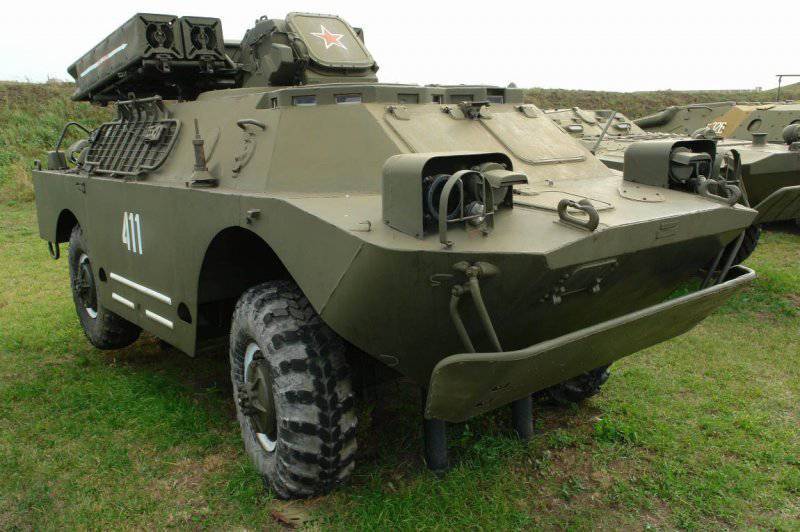
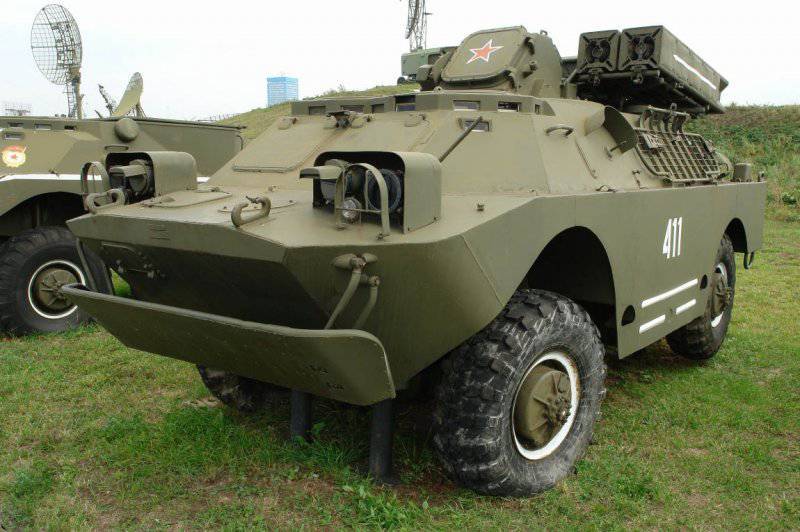
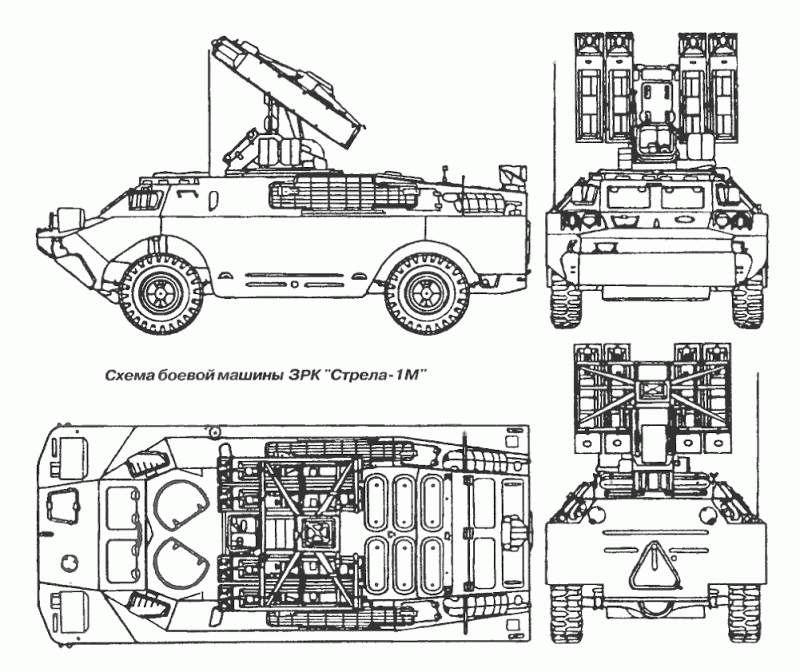
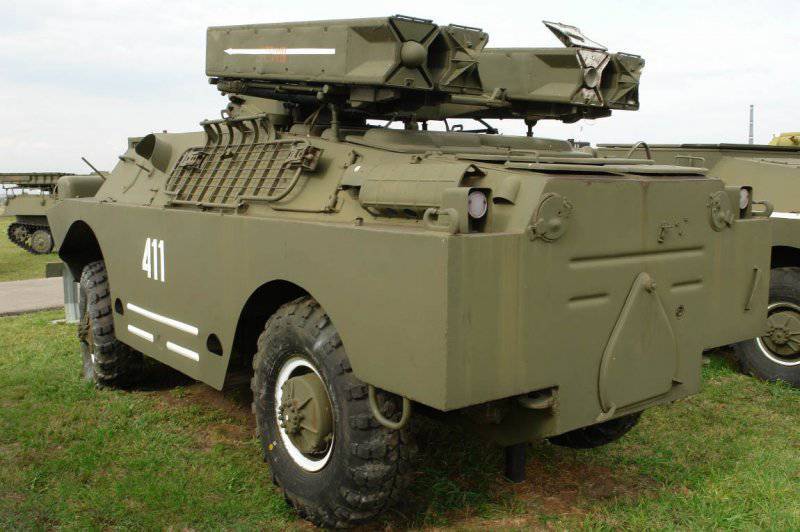
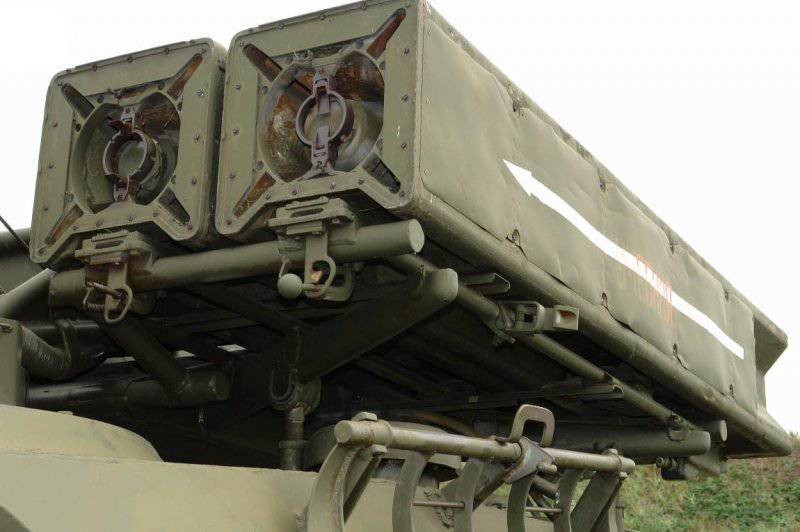
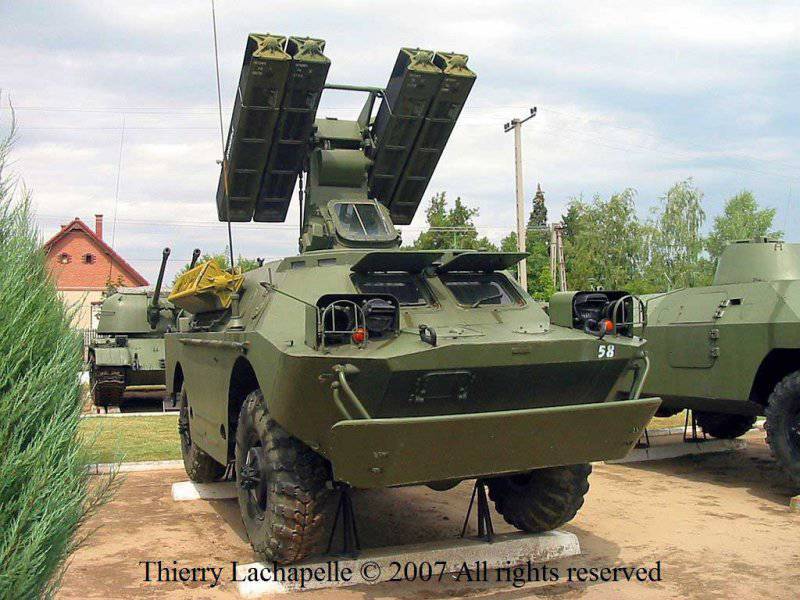
Information